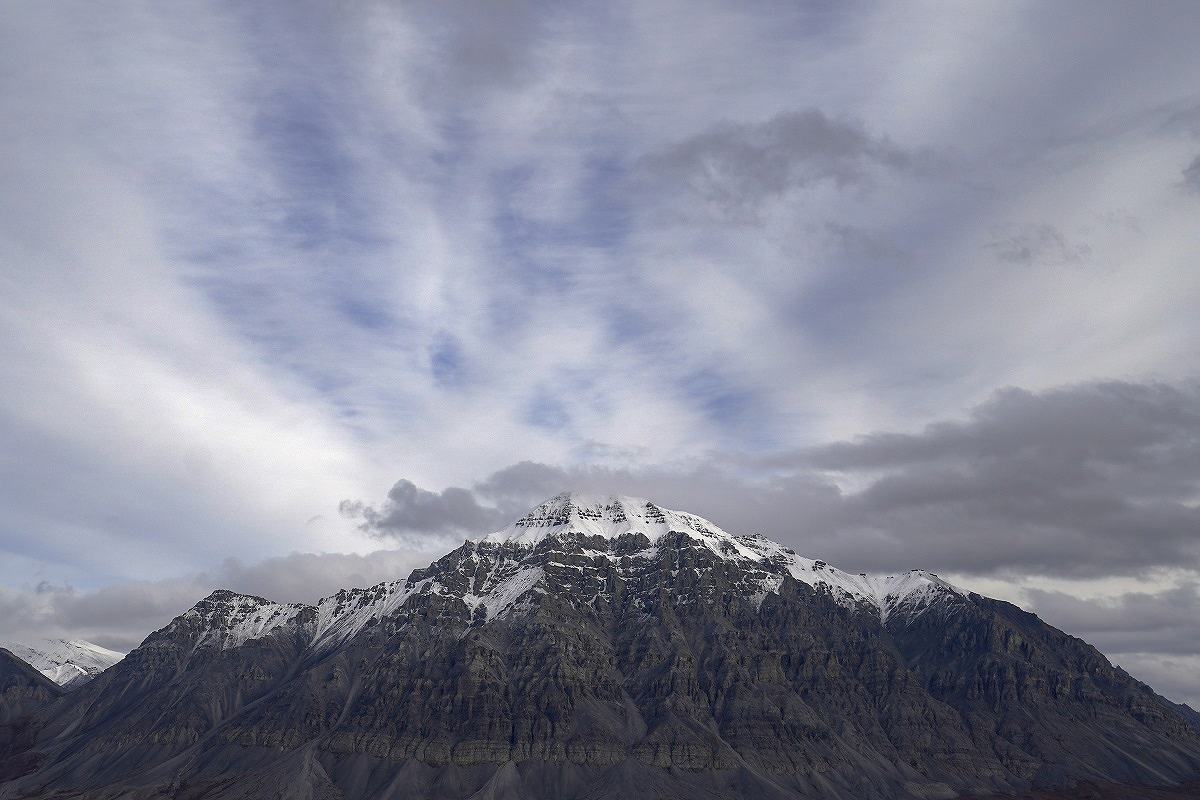
The Brooks Range in Alaska.
17:07 JST, February 17, 2024
When the Grim Reaper calls, will you be carving a holiday turkey or setting off Fourth of July fireworks? Or will the evanescence of your days be marked by the brief spasm of cherry blossoms in bloom?
In other words, what time of year are you most likely to die?
You’d think an inquiry on this subject would begin with Missouri’s third-most famous poet, T.S. Eliot, who called April the cruelest month. Or we could start with famed oath-slinger Hippocrates and his 400 B.C. observations on sickness and the seasons. But we have a source that tops them both: Reader Laurie Schwede from Silver Spring, Md. She sent us a theory.
“I’ve got a hunch that there seem to be noticeably more celebrity deaths, obituary notices, and deaths of my family members and friends in November, December and January than in other months,” Schwede wrote. Does the data back her up?
Yes! Mostly.
On average, January is America’s deadliest month, according to our analysis of data on 66.8 million deaths going all the way back to 1999 collected by the Centers for Disease Control and Prevention. Other lethal months come later in winter – February and March – than Schwede guessed. December ranks fourth. (Other data reveal Jan. 1 as the deadliest single day, though death ramps up throughout the Christmas season.)
The seasonal swings are substantial. About 20 percent more people die in January than in August, which is typically the least lethal month. We’re basing our conclusion on deaths per day, of course. Otherwise, March consistently would look deadlier than February, since it’s usually got three extra days to work with.
Demographer Roland Rau wrote his dissertation on seasonal deaths and remains enthusiastic about the subject many years later. When we Zoomed him at the University of Rostock, on the Baltic Sea, he’d hastily donned a stylish collared white shirt and jacket to look presentable for the august Washington Post, then laughed as a data columnist popped up in his trademark hoodie and raggedy beard.
Rau explained that the winter death pattern doesn’t really emerge until we hit middle age, when we “are less able to withstand adverse environmental conditions. The data suggest that your body is not able to cope well with cold temperatures.”
He said research has shown that seasonal peaks are driven by some of the biggest killers in America: heart disease and respiratory infections. Other major killers, such as cancer and accidents, don’t show the same big cold-month swings, giving us some clues about the physical forces at work.
Winters are deadlier because cold changes our bodies, according to a 2017 review by Simon Stewart, Ashley Keates and Adele Redfern, then of Australian Catholic University, and John McMurray of the University of Glasgow. As temperatures drop, our blood vessels contract. As they narrow, our hearts work harder, our heart rates and blood pressure rise, and clots become more likely. If you’re already at risk of a heart attack or stroke, it’s more likely to hit in winter.
Our tendency to sit around indoors when winter hits compounds the risk. Add in the need for brief bouts of strenuous exertion in the cold – experts say there’s strong evidence that activities like shoveling snow can trigger heart attacks and other heart issues, for example – and winter can be a recipe for disaster.
Cold weakens our defenses against flu, pneumonia, acute bronchitis and other respiratory infections, all of which see some of the sharpest winter spikes. They don’t move the overall death needle as much as heart disease, because they kill so many fewer people. But it’s possible that infections should get the blame for some of those heart deaths: Researchers have found that flu and its friends can accelerate the hardening of your arteries and even raise your near-term risk of heart disease and stroke.
“There is strong evidence that colds and flu leave you vulnerable to acute event, probably by provoking inflammation, which can mean existing blockages in our arteries becoming inflamed and the blood becomes ‘stickier,’ leading to a potentially deadly clot,” said Stewart, an author of the previously mentioned review. Stewart – the force behind many widely cited works on heart disease – is now at the University of Notre Dame Australia.
The coronavirus is no exception to the heart-disease-infection connection. During the pandemic, 2020 and 2021 saw the biggest jump in heart disease deaths in decades, according to the American Heart Association and CDC data.
Of course, you’ll recall that the coronavirus didn’t always obey typical seasonal patterns. January remained the most fatal month in the pandemic era, but December and November also grew deadlier, rising to second and fourth place, respectively. It could be that reader Schwede’s impression of more late-fall obituaries was shaped by the pandemic. These days, the kindest month also has shifted from August to June.
What about suicides? you ask. Rau notes that while depression is often associated with long, gray winters, suicides do not, in fact, peak in winter. U.S. suicides are actually highest on average in August, though the monthly peak in any given year varies from Eliot’s cruelest month to September.
(Editor’s note: At some point, we should probably run the numbers on famous poets by state. For now, our assessment that Langston Hughes of Joplin and Maya Angelou of St. Louis outrank Eliot in the born-in-Missouri bracket is a brazen, unadulterated guesstimate based on no data whatsoever.)
Curiously, the relative deadliness of winter seems to be a modern invention, like mass spectrometry and thinking about the Roman empire on a daily basis. Speaking of which, Rau pointed out that some of the earliest data on death patterns comes from one of our new favorite sources: the bones of Christians in ancient Rome.
For the vast majority of our time on Earth, humans have been awful at keeping death records. To measure the seasonality of death among ancient people, Stanford’s Walter Scheidel had to find people obsessive enough to note the month and day of their deaths – folks who, he wrote, had “a strong preoccupation with the afterlife.” He found it in early Christians living from about A.D. 390 to 600. They buried their dead in catacombs and lovingly inscribed death dates in each niche. To these believers, “the moment of death was considered the beginning of real life in eternity,” Scheidel writes.
Scheidel analyzed the work of intrepid researchers who combed the catacombs to collect about 4,000 such inscriptions. This gives us evidence that the deadliest month in ancient Rome was September, when malaria rampaged through the capital, aided and abetted by all the infectious diseases you’d expect to erupt in the hot-weather months of a civilization that hadn’t fully developed refrigeration or sanitation.
Schwede, the reader who set us down this path, is a retired anthropologist who conducted survey research at the Census Bureau; you may remember her from such works as “Is this a Mobile Home or a Monastery: Differentiating Group Quarters from Housing Units with a Validation Questionnaire.” An irrepressible idea machine with a “feverish brain” (her words, but they could have been describing us), she was kind enough to do our favorite part of our job for us: speculating on what the data might show if we dug deeper.
Most notably, she said, if the death spike depends on cold and dark – and it does – shouldn’t that mean winter grows deadlier as we go farther north? And shouldn’t it mean the death curve flips entirely in the Southern Hemisphere?
Schwede nailed that last part. The deadliest month in Australia, Earth’s smallest continent, is August, and the kindest is January, according to pre-pandemic figures from the Australian Bureau of Statistics – which led us to believe that Schwede’s broader theory must be bulletproof.
But, uh, the data didn’t cooperate. U.S. states have similar seasonal death patterns regardless of latitude or weather. And the outliers, where they exist, mock our thesis. In Alaska, land of the midnight sun in summer and the midday moon in winter, the pattern shows the least seasonality of any state in the nation. Meanwhile, sunny states such as California, Georgia and Texas sport winter death peaks as sharp and clear as the Brooks Range.
Rau tells us that this counterintuitive pattern is even more pronounced in some European countries. Iceland and Russia show small spikes in the winter, according to the European Union’s excellent statistics service, while seasonal deaths soar in Portugal and Spain, the sort of places Northern Europeans go to escape real winter.
How could that be?
Rau, resplendent in his formal shirt, a hip floral print peeking from the lining, said it was a matter of culture and adaptation. After all, your body doesn’t care what the temperature is outside of your clothing, no matter how classy they may be. “In the regions with colder winters, people are better dressed for the cold weather. They wear more layers,” he told us. “They spend less time outdoors.”
It could also be that Alaskan summers see more death than Southern summers do. An Alaska summer can be colder than a Florida winter. But wherever you are, you adapt. The physiological responses that make winters deadly may grow less severe the longer you’re exposed to the cold.
“When you live in a milder climate, you are less likely to be adapted via behaviors, habitat and culture to weather extremes. You are more likely to be adapted to warmer weather,” Stewart told us via email while traveling in icy northern Europe in the middle of the Australian summer. “In relative terms, colder weather is a greater challenge to the body, especially when you don’t have the right clothes and housing.”
Of course, our bodies and culture adapted to a climate pattern that becomes less relevant every year. The carbon dioxide and methane we’ve dumped into the atmosphere is already causing warmer winters and less-predicable extreme weather, throwing our hard-won seasonal death defenses into doubt.
“As climate change occurs, our long-term adaptations to predictable weather seasons is likely to be eroded,” said Stewart, who is writing a book to be titled “Heart Disease & Climate Change.” “People with preexisting conditions like diabetes and heart disease are more vulnerable to this phenomenon.”
"News Services" POPULAR ARTICLE
-

American Playwright Jeremy O. Harris Arrested in Japan on Alleged Drug Smuggling
-

Japan’s Nikkei Stock Average as JGB Yields, Yen Rise on Rate-Hike Bets
-

Japan’s Nikkei Stock Average Licks Wounds after Selloff Sparked by BOJ Hike Bets (UPDATE 1)
-

Japanese Bond Yields Zoom, Stocks Slide as Rate Hike Looms
-

Japan’s Nikkei Stock Average Buoyed by Stable Yen; SoftBank’s Slide Caps Gains (UPDATE 1)
JN ACCESS RANKING
-

Keidanren Chairman Yoshinobu Tsutsui Visits Kashiwazaki-Kariwa Nuclear Power Plant; Inspects New Emergency Safety System
-

Imports of Rare Earths from China Facing Delays, May Be Caused by Deterioration of Japan-China Relations
-

University of Tokyo Professor Discusses Japanese Economic Security in Interview Ahead of Forum
-

Japan Pulls out of Vietnam Nuclear Project, Complicating Hanoi’s Power Plans
-

Govt Aims to Expand NISA Program Lineup, Abolish Age Restriction





















